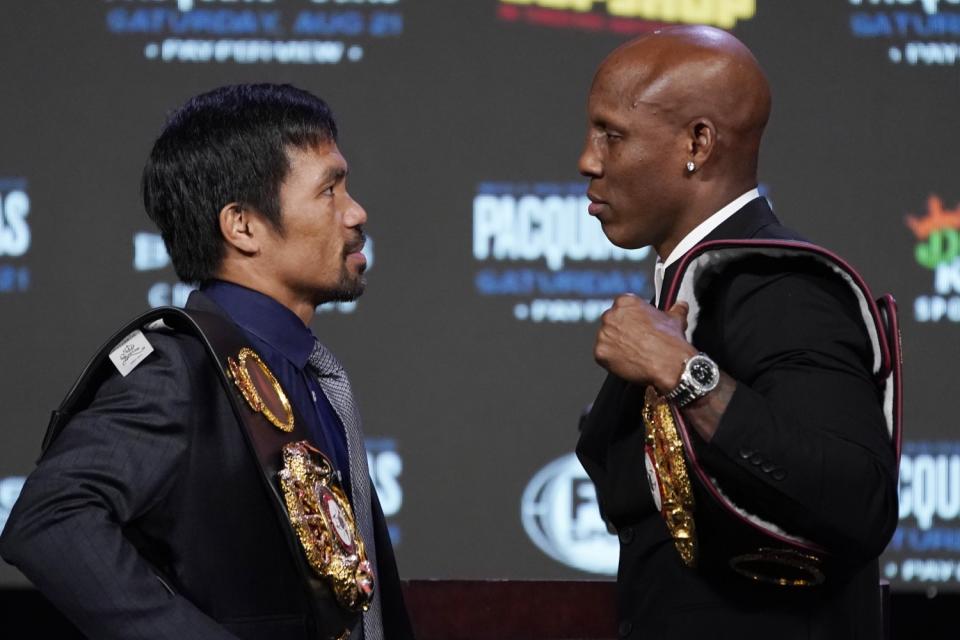Hernández: This is why tonight must be Manny Pacquiao's final fight

The familiar voice came from somewhere off-camera, with Manny Pacquiao’s longtime publicist offering a playful rebuttal to a line I’ve recycled several times in recent years.
“Boxing isn’t dead!” Fred Sternberg shouted.
Well, I replied, it will be when his most famous client retires.
Pacquiao was on my computer screen by this point, cracking up as he settled in for a video conference set up by the ever-jovial Sternberg.
“I’m still alive,” a smiling Pacquiao reminded me.
He’s still alive and still fighting, his next assignment Saturday night at T-Mobile Arena, where he will take on Yordenis Ugás, a late injury replacement for welterweight world champion Errol Spence Jr.
Pacquiao is more than a decade removed from his peak, but he remains a valuable commodity in a field short on star power. He is the last of his kind, the fighter who transcends both his sport and ethnicity.
So, if the hints he dropped this week about retirement were a source of optimism for some, they were a reason for concern for the more self-interested parties in the industry.
“It could be my last fight, or there could be more,” Pacquiao said.
Hopefully, this isn’t a desperate sales pitch to sell a pay-per-view show involving an unknown opponent. Pacquiao turns 43 in December. He’s expected to run for the Philippines' presidency next year. He should retire, and retire soon.
Because if Pacquiao wants to continue fighting, this business will continue indulging him until it has squeezed every nickel from his once-explosive, 5-foot-6 frame.
Boxing’s ecosystem has long relied on fading stars to create the next generation of main attractions. The passing of the torch is a particularly distasteful process, a diminished veteran taking a one-sided beating from his appointed successor in exchange for a hefty payday.
A shopworn Julio César Chávez was mauled by Oscar De La Hoya, who a decade later was whipped by Pacquiao. The next link in the chain was expected to be Spence, a hard-punching champion who at 31 still doesn’t have a signature victory.
But Spence was forced to withdraw from his scheduled showdown with Pacquiao on Saturday after an eye injury was discovered in a pre-fight screening. Spence was replaced by Ugás.
The change diminished enthusiasm for the promotion, but that has radically transformed the atmosphere of fight week. Rather than a countdown to Pacquiao’s demise, the days leading up to the 12-round contest have become a celebration of a career that has spanned more than 26 years.
That certainly beats the alternative.

Before Pacquiao's decision victory over the powerful but technically limited Keith Thurman in 2019, trainer Freddie Roach identified Spence as one of two boxers he didn’t want Pacquiao fighting. Terence Crawford was the other.
“They’re all beatable on a good night for Manny,” Roach said at the time, “but you can’t really count on having a good night every time at 40 years old.”
That was two years ago.
The same conversation with Roach later shifted to the sense of safety Pacquiao feels because of his religious convictions.
“I don’t think God is a good matchmaker,” Roach said.
Earlier this week, Pacquiao pushed back against the perception that he was in danger against the undefeated Spence, who at 5 feet 10 is four inches taller.
Pacquiao pointed to his recent workouts, which he compared to his first training camp with Roach at the Wild Card gym in Hollywood in the early 2000s.
“Every day in training, [I argued] to add more rounds,” Pacquiao said.
Pacquiao, who weighed in Friday at 146 pounds, will be taking on a particularly hittable opponent. Unlike many other products of Cuba’s vaunted amateur program, Ugás isn’t much of a mover, perhaps in part because he’s also old. He's 35.
Ugás, who weighed in at the welterweight limit of 147 pounds, loops his right hand. He often leaves his chin exposed, after throwing his jab and when leaning back to dodge punches.
Pacquiao will have openings. Then again, the openings are usually there for old fighters; their hands just can’t react quickly enough and take advantage of them. De La Hoya learned this in his loss to Pacquiao.
The guess here is that Pacquiao ambushes Ugás early and wins comfortably, perhaps even by a stoppage, but this very well could be the night he slows down just enough to not be able to defeat a fighter of Ugás’ caliber. Either way, Pacquiao will have avoided the kind of humiliations to which the likes of De La Hoya, Sugar Ray Leonard and Muhammad Ali were subjected late in their careers, which is a triumph of sorts. He shouldn’t push his luck beyond it.
This story originally appeared in Los Angeles Times.

